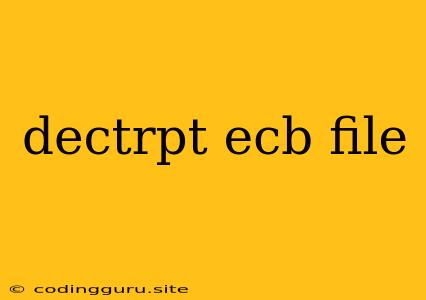Decrypting ECB Files: A Guide to Understanding and Implementing the Process
Electronic Codebook (ECB) is a basic block cipher mode of operation. While simple and efficient, it's known for its lack of security due to its susceptibility to attacks, especially when dealing with repetitive data. This is why ECB mode is generally not recommended for practical applications and is often replaced by more robust encryption modes like Cipher Block Chaining (CBC) or Counter (CTR).
Understanding the ECB Mode
How does ECB work?
In ECB, each block of plaintext is encrypted independently. This means that identical blocks of plaintext will result in identical blocks of ciphertext, creating a predictable pattern. This predictability makes it vulnerable to various attacks.
What are the risks of using ECB?
Here's a breakdown of the major risks associated with ECB mode:
- Pattern Recognition: As mentioned earlier, identical plaintext blocks produce identical ciphertext blocks. An attacker can analyze the ciphertext for patterns, potentially revealing sensitive information.
- Frequency Analysis: If the plaintext contains common words or patterns, an attacker might be able to deduce the original message by analyzing the frequency of specific ciphertext blocks.
- Known-Plaintext Attacks: Even if a small portion of the plaintext is known, an attacker can use this information to decrypt the entire message.
Decrypting ECB Files: A Step-by-Step Approach
Can you decrypt ECB files?
While decrypting ECB files is possible, it's important to consider the risks involved. Always be cautious when dealing with data encrypted with ECB.
The process of decryption typically involves the following steps:
-
Identifying the Encryption Algorithm: First, you need to determine the specific encryption algorithm used to encrypt the file. This information might be provided by the source of the file, or you might have to infer it based on the file extension or other clues. Common encryption algorithms used with ECB include AES, DES, and 3DES.
-
Obtaining the Encryption Key: The encryption key is essential for decrypting the file. Without the correct key, you cannot decrypt the file. The key might be provided separately or might be embedded within the file itself.
-
Choosing a Decryption Library: Several programming libraries and tools can be used to decrypt files encrypted with ECB. These libraries typically support various encryption algorithms and allow you to specify the key and other relevant parameters.
-
Decrypting the Data: Once you have the necessary information (algorithm, key, and decryption library), you can start the decryption process. The library will handle the decryption process, converting the ciphertext back into plaintext.
Note: Decrypting a file encrypted with ECB is not guaranteed to be successful. Several factors can hinder the decryption process, including:
- Incorrect Key: If the decryption key is wrong, you won't be able to decrypt the file.
- Unknown Encryption Algorithm: If the encryption algorithm used is unknown or unsupported by your chosen decryption tool, you won't be able to decrypt the file.
- Corrupted File: A corrupted file can prevent successful decryption.
Best Practices and Considerations
- Avoid ECB: The most crucial step is to avoid ECB encryption altogether. Opt for more secure encryption modes like CBC, CTR, or GCM.
- Secure Key Management: Always use strong and unique encryption keys. Securely store and manage these keys to prevent unauthorized access.
- Data Integrity Verification: Consider using cryptographic hash functions to verify the integrity of the data after decryption. This helps ensure that the data hasn't been tampered with during the process.
Example Decryption with Python and PyCryptodome
Let's illustrate a simple decryption example using Python and the PyCryptodome library:
from Crypto.Cipher import AES
from Crypto.Random import get_random_bytes
# Encryption Key
key = get_random_bytes(16)
# Ciphertext (replace with your actual file)
ciphertext = b'...'
# Decryption
cipher = AES.new(key, AES.MODE_ECB)
plaintext = cipher.decrypt(ciphertext)
# Print the decrypted data
print(plaintext)
Important: This example is for illustrative purposes only and should not be used for actual decryption in a production environment.
The get_random_bytes(16) function generates a 16-byte random key for AES encryption. Remember to replace ciphertext with the actual ciphertext from your file.
Remember: Always consult the documentation of your chosen decryption library for the correct implementation and usage instructions.
Conclusion
Decrypting files encrypted with ECB is possible, but it comes with significant security risks. The ECB mode is considered insecure due to its vulnerability to various attacks. It's highly recommended to use stronger encryption modes that provide better security and data integrity. Always prioritize secure key management and data integrity verification during the decryption process.
